Celery vase
The development of pressed glass during the 1820s was the most innovative technological improvement since the invention of the blowpipe two thousand years earlier. Credited as an American development, it revolutionized glassmaking, taking the process out of the hands of the individual glass blower, and enabling the shape and decoration of an object to be made in a single swift process. Cut glass provides the patterns for the earliest pressed vessels, such as this celery vase. It features repeated designs of what appear to be tulip blossoms (although collectors often refer to this as the Cape Cod Lily) and leaves. The Boston and Sandwich Glass Company produced quantities of lacy pressed glass. Based upon fragments found at Sandwich factory site, the celery is attributed to that firm. It is one of a very few examples known.
Artwork Details
- Title:Celery vase
- Maker:Attributed to Boston & Sandwich Glass Company (American, 1825–1888, Sandwich, Massachusetts)
- Date:1827–35
- Geography:Made in Sandwich, Massachusetts, United States
- Culture:American
- Medium:Pressed glass
- Dimensions:H. 7 5/16 in. (18.6 cm); Diam. 4 9/16 in. (11.6 cm)
- Credit Line:Purchase, Mr. and Mrs. Paul Greenwood Gift, 1986
- Object Number:1986.237
- Curatorial Department: The American Wing
More Artwork
Research Resources
The Met provides unparalleled resources for research and welcomes an international community of students and scholars. The Met's Open Access API is where creators and researchers can connect to the The Met collection. Open Access data and public domain images are available for unrestricted commercial and noncommercial use without permission or fee.
To request images under copyright and other restrictions, please use this Image Request form.
Feedback
We continue to research and examine historical and cultural context for objects in The Met collection. If you have comments or questions about this object record, please contact us using the form below. The Museum looks forward to receiving your comments.
